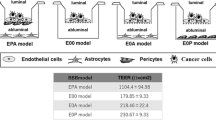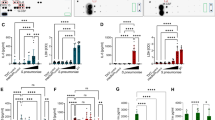Abstract
Angiogenesis is an important physiological and pathological process. Bartonella is the only genus of bacteria known to induce pathological angiogenesis in the mammalian host. Bartonella-induced angiogenesis leads to the formation of vascular tumors including verruga peruana and bacillary angiomatosis. The mechanism of Bartonella-induced angiogenesis is not completely understood. Pericytes, along with endothelial cells, play an important role in physiological angiogenesis, and their role in tumor angiogenesis has been extensively studied. Abnormal signaling between endothelial cells and pericytes contributes to tumor angiogenesis and metastasis; however, the role of pericytes in Bartonella-induced angiogenesis is not known. In this study, after infecting human brain vascular pericytes (HBVPs) with Bartonella henselae, we found that these bacteria were able to invade HBVPs and that bacterial infection resulted in decreased pericyte proliferation and increased pericyte production of vascular endothelial growth factor (VEGF) when compared to the uninfected control cells. In the context of pathological angiogenesis, reduced pericyte coverage, accompanied by increased VEGF production, may promote endothelial cell proliferation and the formation of new vessels.




Similar content being viewed by others
References
Dehio C (2005) Bartonella-host-cell interactions and vascular tumour formation. Nat Rev Microbiol 3:621–631
Ganem D (2010) KSHV and the pathogenesis of Kaposi sarcoma: listening to human biology and medicine. J Clin Invest 120:939–949
Kontoyiannis DP (2010) Manipulation of host angiogenesis: a critical link for understanding the pathogenesis of invasive mold infections? Virulence 1:192–196
Koehler JE, Tappero JW (1993) Bacillary angiomatosis and bacillary peliosis in patients infected with human immunodeficiency virus. Clin Infect Dis 17:612–624
Kempf VA, Volkmann B, Schaller M, Sander CA, Alitalo K, Riess T, Autenrieth IB (2001) Evidence of a leading role for VEGF in Bartonella henselae-induced endothelial cell proliferations. Cell Microbiol 3:623–632
Leung DW, Cachianes G, Kuang WJ, Goeddel DV, Ferrara N (1989) Vascular endothelial growth factor is a secreted angiogenic mitogen. Science 246:1306–1309
Hansen A, Boshoff C, Lagos D (2007) Kaposi sarcoma as a model of oncogenesis and cancer treatment. Expert Rev Anticancer Ther 7:211–220
Moss SF, Malfertheiner P (2007) Helicobacter and gastric malignancies. Helicobacter 12:23–30
Lax AJ, Thomas W (2002) How bacteria could cause cancer: one step at a time. Trends Microbiol 10:293–299
Rudikoff D, Phelps RG, Gordon RE, Battone EJ (1989) Acquired immunodeficiency syndrome-related bacillary vascular proliferation (epithelioid angiomatosis): rapid response to erythromycin therapy. Arch Dermatol 125:706–707
Breitschwerdt EB, Maggi RG, Varanat M, Linder KE, Weinberg G (2009) Isolation of Bartonella vinsonii subsp. berkhoffii genotype II from a boy with epithelioid hemangioendothelioma and a dog with hemangiopericytoma. J Clin Microbiol 47:1957–1960
Varanat M, Maggi RG, Linder KE, Breitschwerdt EB (2011) Molecular prevalence of Bartonella, Babesia, and hemotropic Mycoplasma sp. in dogs with splenic disease. J Vet Intern Med 25:1284–1291
Díaz-Flores L, Gutiérrez R, Madrid JF, Varela H, Valladares F, Acosta E, Martín-Vasallo P, Díaz-Flores L Jr (2009) Pericytes. Morphofunction, interactions and pathology in a quiescent and activated mesenchymal cell niche. Histol Histopathol 24:909–969
Hirschi KK, D’Amore PA (1996) Pericytes in the microvasculature. Cardiovasc Res 32:687–698
Reinmuth N, Liu W, Jung YD, Ahmad SA, Shaheen RM, Fan F, Bucana CD, McMahon G, Gallick GE, Ellis LM (2001) Induction of VEGF in perivascular cells defines a potential paracrine mechanism for endothelial cell survival. FASEB J 15:1239–1241
Raza A, Franklin MJ, Dudek AZ (2010) Pericytes and vessel maturation during tumor angiogenesis and metastasis. Am J Hematol 85:593–598
Maggi RG, Harms CA, Hohn AA, Pabst DA, McLellan WA, Walton WJ, Rotstein DS, Breitschwerdt EB (2005) Bartonella henselae in porpoise blood. Emerg Infect Dis 11:1894–1898
Breitschwerdt EB, Maggi RG, Duncan AW, Nicholson WL, Hegarty BC, Woods CW (2007) Bartonella species in blood of immunocompetent persons with animal and arthropod contact. Emerg Infect Dis 13:938–941
Maeno N, Oda H, Yoshiie K, Wahid MR, Fujimura T, Matayoshi S (1999) Live Bartonella henselae enhances endothelial cell proliferation without direct contact. Microb Pathog 27:419–427
Kirby JE, Nekorchuk DM (2002) Bartonella-associated endothelial proliferation depends on inhibition of apoptosis. Proc Natl Acad Sci USA 99:4656–4661
McCord AM, Resto-Ruiz SI, Anderson BE (2006) Autocrine role for interleukin-8 in Bartonella henselae-induced angiogenesis. Infect Immun 74:5185–5190
Dehio C, Meyer M, Berger J, Schwarz H, Lanz C (1997) Interaction of Bartonella henselae with endothelial cells results in bacterial aggregation on the cell surface and the subsequent engulfment and internalisation of the bacterial aggregate by a unique structure, the invasome. J Cell Sci 110:2141–2154
Rhomberg TA, Truttmann MC, Guye P, Ellner Y, Dehio C (2009) A translocated protein of Bartonella henselae interferes with endocytic uptake of individual bacteria and triggers uptake of large bacterial aggregates via the invasome. Cell Microbiol 11:927–945
Kyme PA, Haas A, Schaller M, Peschel A, Iredell J, Kempf VA (2005) Unusual trafficking pattern of Bartonella henselae -containing vacuoles in macrophages and endothelial cells. Cell Microbiol 7:1019–1034
Diaz-Flores L, Gutierrez R, Varela H (1992) Behavior of postcapillary venule pericytes during postnatal angiogenesis. J Morphol 213:33–45
Benjamin LE, Hemo I, Keshet E (1998) A plasticity window for blood vessel remodeling is defined by pericyte coverage of the preformed endothelial network and is regulated by PDGF-B and VEGF. Development 125:1591–1598
Cao Y, Sonveaux P, Liu S, Zhao Y, Mi J, Clary BM, Li CY, Kontos CD, Dewhirst MW (2007) Systemic overexpression of angiopoietin-2 promotes tumor microvessel regression and inhibits angiogenesis and tumor growth. Cancer Res 67:3835–3844
Greenberg JI, Shields DJ, Barillas SG, Acevedo LM, Murphy E, Huang J, Scheppke L, Stockmann C, Johnson RS, Angle N, Cheresh DA (2008) A role for VEGF as a negative regulator of pericyte function and vessel maturation. Nature 456:809–813
Aiello LP, Northrup JM, Keyt BA, Takagi H, Iwamoto MA (1995) Hypoxic regulation of vascular endothelial growth factor in retinal cells. Arch Ophthalmol 113:1538–1544
Yamagishi S, Yonekura H, Yamamoto Y, Fujimori H, Sakurai S, Tanaka N, Yamamoto H (1999) Vascular endothelial growth factor acts as a pericyte mitogen under hypoxic conditions. Lab Invest 79:501–509
Fuhrmann O, Arvand M, Göhler A, Schmid M, Krüll M, Hippenstiel S, Seybold J, Dehio C, Suttorp N (2001) Bartonella henselae induces NF-kappaB-dependent upregulation of adhesion molecules in cultured human endothelial cells: possible role of outer membrane proteins as pathogenic factors. Infect Immun 69:5088–5097
Cerimele F, Brown LF, Bravo F, Ihler GM, Kouadio P, Arbiser JL (2003) Infectious angiogenesis: Bartonella bacilliformis infection results in endothelial production of angiopoietin-2 and epidermal production of vascular endothelial growth factor. Am J Pathol 163:1321–1327
Li A, Dubey S, Varney ML, Dave BJ, Singh RK (2003) IL-8 directly enhanced endothelial cell survival, proliferation, and matrix metalloproteinases production and regulated angiogenesis. J Immunol 170:3369–3376
Johnson GK, Guthmiller JM, Joly S, Organ CC, Dawson DV (2010) Interleukin-1 and interleukin-8 in nicotine- and lipopolysaccharide-exposed gingival keratinocyte cultures. J Periodontal Res 45:583–588
Matera G, Liberto MC, Quirino A, Barreca GS, Lamberti AG, Iannone M, Mancuso E, Palma E, Cufari FA, Rotiroti D, Focà A (2003) Bartonella quintana lipopolysaccharide effects on leukocytes, CXC chemokines and apoptosis: a study on the human whole blood and a rat model. Int Immunopharmacol 3:853–864
Schülein R, Seubert A, Gille C, Lanz C, Hansmann Y, Piémont Y, Dehio C (2001) Invasion and persistent intracellular colonization of erythrocytes. A unique parasitic strategy of the emerging pathogen Bartonella. J Exp Med 193:1077–1086
Gengler C, Guillou L (2006) Solitary fibrous tumour and haemangiopericytoma: evolution of a concept. Histopathology 48:63–74
Fletcher CD (2006) The evolving classification of soft tissue tumours: an update based on the new WHO classification. Histopathology 48:3–12
Koch M, Nielsen GP, Yoon SS (2008) Malignant tumors of blood vessels: angiosarcomas, hemangioendotheliomas, and hemangioperictyomas. J Surg Oncol 97:321–329
Beerlage C, Varanat M, Linder K, Maggi RG, Cooley J, Kempf VA, Breitschwerdt EB (2012) Bartonella vinsonii subsp. berkhoffii and Bartonella henselae as potential causes of proliferative vascular diseases in animals. Med Microbiol Immunol. Published online 27 March 2012
Acknowledgments
We would like to thank Dr. Maria Correa and Ms. Elizabeth Pultorak for assistance with the statistical analysis, and Dr. Shila Nordone and Ms. Barbara Hegarty for critically reading the manuscript. This study was funded by American Kennel Club-Canine Health Foundation AKORN grant 01531A. We also thank Bayer Animal Health Foundation for providing stipend support for Dr. Mrudula Varanat who was a graduate student in Intracellular Pathogens Laboratory, North Carolina State University at the time this research was performed.
Author information
Authors and Affiliations
Corresponding author
Rights and permissions
About this article
Cite this article
Varanat, M., Maggi, R.G., Linder, K.E. et al. Infection of human brain vascular pericytes (HBVPs) by Bartonella henselae . Med Microbiol Immunol 202, 143–151 (2013). https://doi.org/10.1007/s00430-012-0279-5
Received:
Accepted:
Published:
Issue Date:
DOI: https://doi.org/10.1007/s00430-012-0279-5




